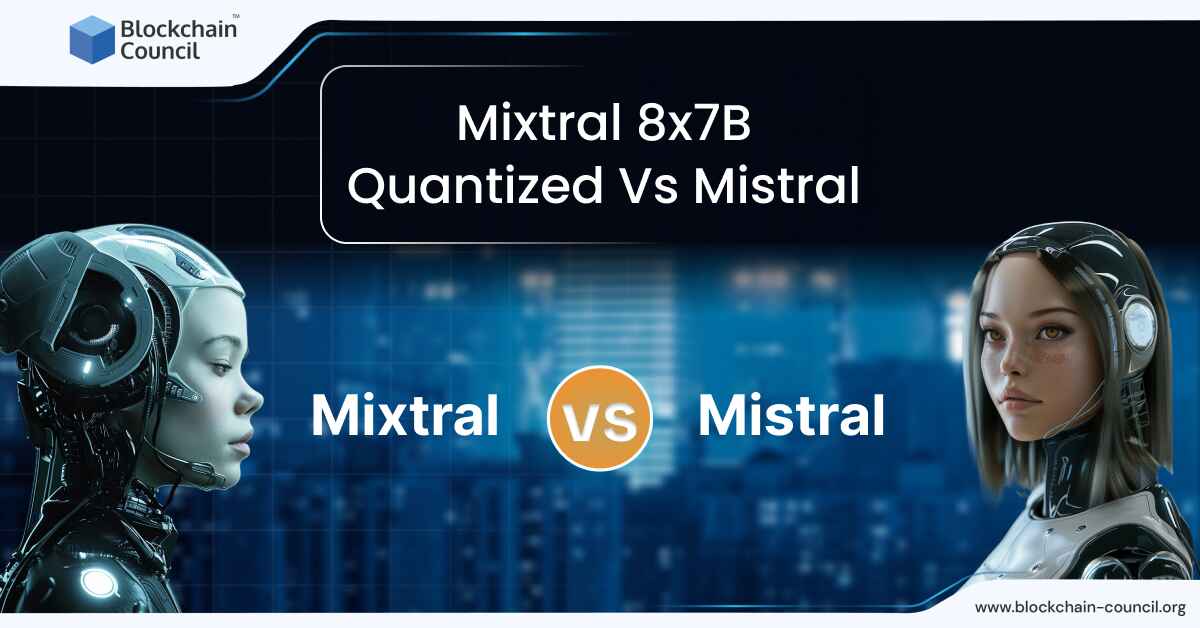
- Blockchain Council
- August 24, 2024
Artificial intelligence models have become more integral to various applications. Therefore, understanding their differences can help you choose the right one for your needs. Two popular models in 2024 are the Mixtral 8x7B quantized and the Mistral 7B. Although they share similarities, each offers unique features suited for specific tasks.
Mixtral 8x7B Quantized Vs Mistral – Who Wins?
Large Language Models (LLMs) like Mixtral 8x7B and Mistral 7B are advanced AI tools. They are designed to process and generate human-like text. Such models use lots of data to learn language patterns. Moreover, you can apply them to tasks such as content creation, translation, and even code generation.
The Mistral 7B model and its counterpart, the Mixtral 8x7B, are both part of the Mistral AI family. While they share a common origin, they diverge significantly in terms of architecture and performance. For instance, Mistral 7B is recognized for its simplicity and efficiency. Meanwhile Mixtral 8x7B introduces a more complex design aimed at optimizing performance for larger-scale tasks.
Let’s understand more to understand who wins in Mixtral 8x7B Quantized Vs Mistral
What is Mixtral 8x7B Quantized?
Mixtral 8x7B is an advanced model developed by Mistral AI. It is famous for its Sparse Mixture-of-Experts (SMoE) architecture. This architecture involves using a large set of parameters. However, only a subset is active during any given inference. Although Mixtral 8x7B has around 56 billion parameters on paper, it only utilizes a fraction of them—approximately 12 billion—at any given time during inference.
This means that it processes data in chunks using multiple “experts.” This way it can deliver powerful results while keeping costs and processing time low. Further, Mixtral 8x7B can manage a large context window of up to 32k tokens.
Now, the quantized version of Mixtral 8x7B reduces the precision of the model’s calculations. Typically from 32-bit to 8-bit. Hence, it speeds up the model and decreases its memory footprint without significantly sacrificing performance. Therefore, it is an attractive option for those who need high-performance AI in a resource-constrained environment, such as running complex models on less powerful hardware.
What is Mistral 7B?
On the other hand, Mistral 7B is a dense model with 7.3 billion parameters. It’s one of the earlier models from Mistral AI. It can offer efficient performance with fewer resources. Despite its smaller size, Mistral 7B is known for its high-speed processing. Therefore, it is ideal for tasks that require quick responses, such as real-time data processing or rapid content generation. It’s also more cost-effective compared to larger models. This makes it a practical choice for developers working with tight budgets.
Performance Comparison
Architecture and Performance
The primary difference between these two models lies in their architecture.
Firstly, Mistral 7B follows a single-model methodology. However, Mixtral 8x7B integrates multiple smaller models within its framework. This way, it can handle more intricate tasks. Moreover, this architectural complexity allows Mixtral 8x7B to outperform many larger models in the market. It includes Llama 2 and GPT-3.5, particularly in terms of efficiency and speed.
Also, Mixtral 8x7B is better suited for handling longer contexts. As mentioned earlier, it supports context windows of up to 32,000 tokens. This is significantly higher than what Mistral 7B can manage. It makes Mixtral 8x7B more effective for tasks that require understanding and processing large volumes of text.
Speed and Latency
When comparing speed, Mistral 7B outshines Mixtral 8x7B in terms of output speed, processing approximately 114 tokens per second, while Mixtral 8x7B manages around 88.5 tokens per second. However, Mixtral 8x7B compensates with better handling of complex tasks, thanks to its SMoE architecture, which allows it to tackle more intricate queries with higher accuracy.
Cost Efficiency
In terms of cost, Mistral 7B is the more economical option at $0.18 per million tokens. Therefore, it is highly attractive for high-volume tasks. On the other hand, Mixtral 8x7B, while more expensive at $0.50 per million tokens, offers better performance for tasks requiring higher accuracy and complexity.
Contextual Understanding and Multilingual Support
Next, Mixtral 8x7B also excels in managing long-context tasks. Since it supports up to 32k tokens. Mistral 7B has a more limited context window compared to this. This ability makes Mixtral 8x7B superior for applications like document summarization or lengthy conversations. Additionally, Mixtral 8x7B is designed with multilingual capabilities. It can give support for English, German, French, Spanish, and Italian. Whereas Mistral 7B primarily focuses on English.
Use Cases: When to Choose Which?
So what to choose in Mixtral 8x7B Quantized Vs Mistral?
If your application demands high speed and low cost, Mistral 7B is the ideal choice. It’s perfect for tasks where quick responses are more critical than handling complex inputs, such as real-time language translation or chatbots that need to operate at scale.
However, for applications requiring higher complexity, better contextual understanding, or support for multiple languages, Mixtral 8x7B quantized is the better option. Its superior handling of intricate tasks makes it well-suited for technical content creation. It is also better in advanced data analysis, or multilingual tasks where accuracy is paramount.
So, choosing between Mixtral 8x7B quantized and Mistral 7B depends largely on your specific needs. Mistral 7B offers speed and efficiency at a lower cost. So, it is ideal for general-purpose applications. In contrast, Mixtral 8x7B, with its advanced architecture and multilingual capabilities, is better suited for complex, high-stakes tasks where performance outweighs cost.
Conclusion
In conclusion, choosing between Mixtral 8x7B quantized Vs Mistral 7B depends on your specific needs. Mistral 7B is ideal for environments where simplicity, speed, and lower resource requirements are key. Mixtral 8x7B quantized outperforms Mistral 7B in most benchmarks but at the cost of higher complexity.
To understand the ins and outs of such AI models, enroll into expert-guided Master Artificial Intelligence (AI) Learning Path.





































































 Guides
Guides News
News Blockchain
Blockchain Cryptocurrency
& Digital Assets
Cryptocurrency
& Digital Assets Web3
Web3 Metaverse & NFTs
Metaverse & NFTs
